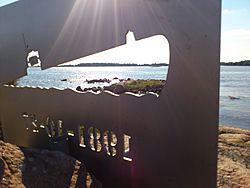Soviet submarine S-363 facts for kids

A plaque at the location of the grounding
|
|
Quick facts for kids History |
|
|---|---|
| Name | S-363 |
| Builder | Ordzhonikidze Yard, Leningrad |
| Yard number | 252 |
| Laid down | 12 January 1956 |
| Launched | 16 November 1956 |
| Commissioned | 17 September 1957 |
| Stricken | 1990s |
| Homeport | Liepāja |
| Fate | Museum ship |
| General characteristics | |
| Class and type | Whiskey-class submarine |
| Displacement | 1,030 t (1,010 long tons) |
| Length | 76 m (249 ft 4 in) |
| Beam | 6.7 m (22 ft 0 in) |
| Draft | 4.6 m (15 ft 1 in) |
| Propulsion |
|
| Speed |
|
| Range | 12,000 nmi (22,000 km) to 15,000 nmi (28,000 km) |
| Test depth | ~400–450 m (1,310–1,480 ft) |
| Complement | ~60 |
| Armament |
|
The Soviet submarine S-363 (unofficially called U137 by Sweden) was a Soviet submarine. It became famous when it got stuck on rocks near the town of Karlskrona in Sweden. This happened on October 27, 1981. After a few days, on November 5, the submarine was carefully moved out of Sweden's waters. This event was a big deal during the Cold War.
Contents
What Was the S-363 Submarine?
The S-363 was a type of submarine known as a Whiskey-class submarine. These submarines were built for the Soviet Union's navy. They were designed to travel long distances underwater. The S-363 was built in Leningrad (now St. Petersburg). It was launched in 1956 and joined the navy in 1957.
Submarine Features
The S-363 was about 76 meters (249 feet) long. That's almost as long as a football field! It could travel at 18 knots (about 33 km/h) on the surface. Underwater, it was slower, moving at 13 knots (about 24 km/h). The submarine had a crew of around 60 people. It was equipped with six torpedo tubes. These could launch torpedoes or lay mines.
The Submarine Gets Stuck
On October 27, 1981, the S-363 was on a mission. It entered Swedish territorial waters without permission. These waters are areas close to a country's coast that it controls. The submarine then ran aground, meaning it got stuck on rocks. This happened near the town of Karlskrona, which is a major Swedish naval base.
Why Was It a Big Deal?
This event was very important because of the Cold War. The Cold War was a time of tension between the Soviet Union and Western countries. A Soviet submarine getting stuck in Sweden's sensitive military area was a huge surprise. It made people wonder why the submarine was there. Some thought it was spying. The incident caused a lot of international attention.
What Happened Next?
For several days, the S-363 remained stuck. Swedish officials questioned the Soviet crew. The Soviet Union said the submarine had made a navigation error. They claimed it was an accident. Sweden insisted the submarine be moved out of its waters. On November 5, 1981, after intense discussions, the S-363 was finally freed. Swedish tugboats helped pull it off the rocks. The submarine then left Swedish waters.
Images for kids


